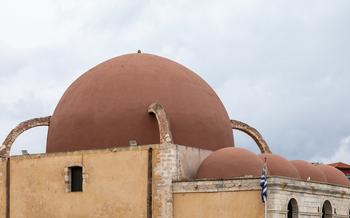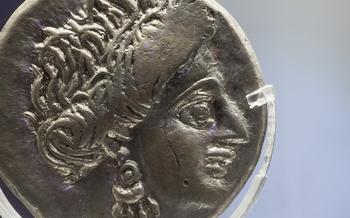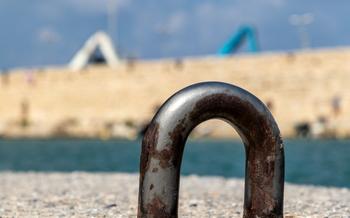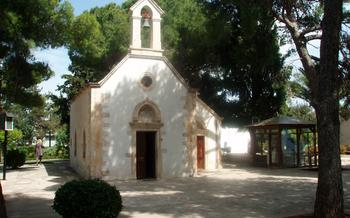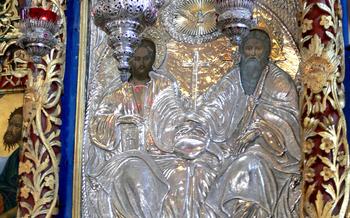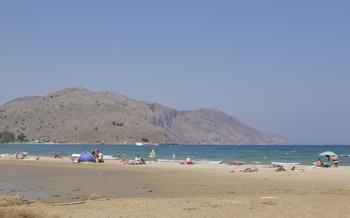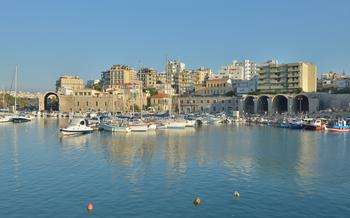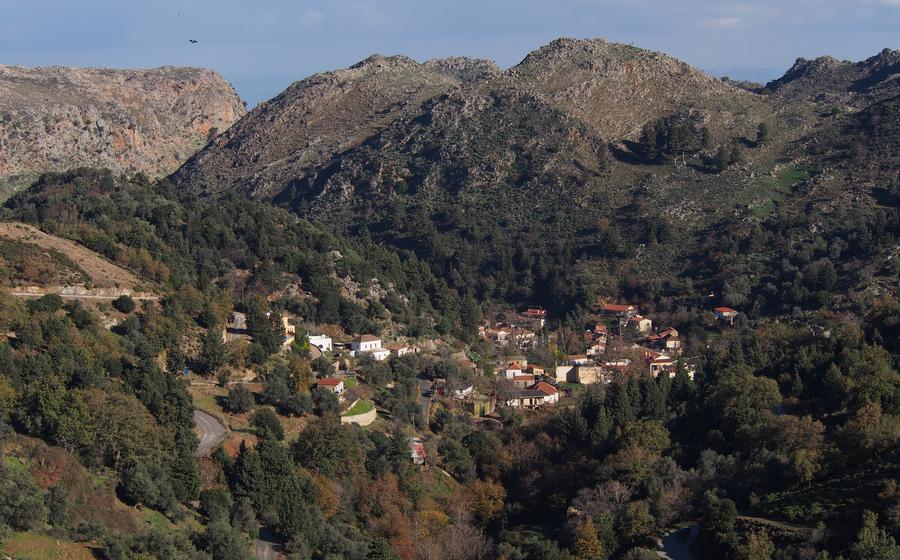
Theriso Gorge
- A picturesque gorge in Crete
- Getting to Theriso Gorge
- The legend of Theriso Gorge
- Hiking in Theriso Gorge
- The village of Theriso
- The Theriso Gorge Museum
- Religious sites in Theriso Gorge
- Wildlife in Theriso Gorge
- The Theriso Gorge Festival
- Rock climbing in Theriso Gorge
- The Monastery of Agia Triada
- Local cuisine in Theriso Gorge
- Souvenirs and local products
- Photography opportunities
- Insider Tip:
A picturesque gorge in Crete
Theriso Gorge, a breathtaking natural wonder nestled in the heart of Crete, invites you to explore its awe-inspiring landscapes and rich cultural heritage. This picturesque gorge, formed by the relentless flow of the Theriso River over millions of years, offers a unique blend of geological marvels, historical significance, hiking adventures, and unparalleled natural beauty.
As you venture into the gorge, you'll be greeted by towering rock formations, carved into intricate shapes by the relentless forces of nature. The gorge's strategic location has also played a crucial role in Crete's history, serving as a natural fortress and hideout during periods of strife. Today, Theriso Gorge stands as a testament to the island's resilience and enduring spirit.
For those seeking an active adventure, the gorge presents a network of well-maintained hiking trails, catering to hikers of all levels. As you traverse the gorge's rugged terrain, you'll be rewarded with breathtaking views that will leave you in awe. The diverse flora and fauna that thrive within the gorge create a vibrant tapestry of life, adding to its allure and making it a haven for nature enthusiasts.
Getting to Theriso Gorge
Theriso Gorge is conveniently located just 15 kilometers southeast of Chania, making it an easily accessible destination for a day trip or a longer stay. Visitors can reach the gorge by car, public transportation, or organized tour.
For those driving, the route to Theriso Gorge is well-marked. From Chania, take the road towards Theriso village and follow the signs to the gorge. The drive takes approximately 25 minutes, and there is ample parking available at the gorge entrance.
Public transportation is also an option, although it may require a bit more planning. Buses run regularly from Chania to Theriso village, and from there, visitors can take a short taxi ride or walk to the gorge entrance.
Lastly, organized tours are available from Chania that include a visit to Theriso Gorge, often combined with other nearby attractions such as the Samaria Gorge or the White Mountains. These tours provide transportation and a guide who can share insights into the history, culture, and natural beauty of the region.
The legend of Theriso Gorge
The history of Theriso Gorge is closely intertwined with Greek mythology and local traditions. According to legend, the gorge was formed by a powerful blow from the trident of Poseidon, the god of the sea, who was angry at the nymph Malaxa for rejecting his advances. The gorge is also associated with the mythical hero Digenis Akritas, who is said to have hidden in the gorge to escape from his enemies.
Over the centuries, Theriso Gorge has witnessed numerous historical events. During the Venetian occupation of Crete, the gorge served as a hideout for rebels and freedom fighters. During World War II, the gorge was used by the Resistance to transport supplies and weapons. The locals of Theriso have a deep connection to their history and culture, and they take pride in sharing their traditions with visitors.
Hiking in Theriso Gorge
Theriso Gorge offers a rewarding hiking experience for nature enthusiasts and adventure seekers. The Gorge has a moderate level of difficulty, suitable for hikers with average fitness and experience. The trail is well-maintained, with clear signage and rest stops. It covers a distance of approximately 6 kilometers and can be completed in 3-4 hours, depending on your pace and the number of stops you take to admire the scenery. Along the way, you'll be treated to breathtaking views of the rocky cliffs, lush vegetation, and the crystal-clear Theriso River that meanders through the canyon. The Gorge is particularly beautiful during the spring when the wildflowers bloom, adding a vibrant splash of color to the landscape.
The village of Theriso
Theriso, nestled amidst the foothills of the White Mountains, is a small, picturesque village that has managed to retain its traditional charm despite the influx of tourism. Its history dates back to the Venetian era, and its cobblestone streets, whitewashed houses, and stately mansions reflect its rich past. Theriso is renowned for its local products, particularly its succulent oranges, which are a testament to the village's fertile soil. Visitors can indulge in these citrus delights and other fresh produce at the local farmers' market, where they can also find an array of handcrafted goods, such as ceramics, woven textiles, and intricate jewelry. Local cuisine is another highlight of Theriso. Family-run tavernas serve up traditional Cretan dishes prepared with fresh, locally sourced ingredients, such as the renowned dakos salad, succulent lamb dishes, and mouthwatering cheese pies. Cooking classes are also available for those who wish to learn the secrets of Cretan cuisine and recreate these culinary delights in their own kitchens.
The Theriso Gorge Museum
The Theriso Gorge Museum, nestled amidst the scenic landscapes of the gorge, provides a fascinating glimpse into the rich history and cultural heritage of the region. Established with the goal of preserving and showcasing the unique identity of Theriso Gorge, this museum houses a collection of artifacts, exhibits, and displays that tell the story of the gorge's geological formation, its role in historical events, and the lives of the people who have inhabited this region for centuries.
Through interactive exhibits and informative panels, the museum offers visitors an immersive journey through time, shedding light on the geological processes that shaped the gorge's dramatic cliffs and ravines, the role it played as a strategic passage during wartime, and the legends and traditions associated with it. Visitors can explore the museum's collection of traditional tools, utensils, and clothing, gaining insights into the daily lives of the local people and their connection to the land.
The museum also serves as an educational resource for students and researchers interested in the history, geology, and ecology of the gorge. Guided tours are available, providing visitors with in-depth knowledge and personal anecdotes about the region's past and present. Whether you're a history buff, a nature enthusiast, or simply curious about the heritage of Theriso Gorge, a visit to the museum is a must to delve deeper into the essence of this remarkable place.
Religious sites in Theriso Gorge
The Theriso Gorge is home to several religious sites that hold significant historical and cultural value. Among them, the most notable is the Monastery of Agia Triada, perched majestically atop a hill overlooking the gorge. Built in the 17th century, the monastery is a splendid example of Venetian-Byzantine architecture, with its whitewashed walls, arched windows, and intricate frescoes adorning the interior. Visitors can explore the monastery's well-preserved cells, where monks once resided, and admire the stunning views of the surrounding landscape from its panoramic terrace.
Another important religious site in the gorge is the Church of Panagia Therisotissa, located in the village of Theriso. Dedicated to the Virgin Mary, the church dates back to the 14th century and features beautiful Byzantine-style frescoes and icons. Locals hold the church in high esteem and celebrate its feast day with a grand festival every year. These religious sites in Theriso Gorge offer a glimpse into the region's rich spiritual heritage and provide a serene retreat for pilgrims and visitors alike.
Wildlife in Theriso Gorge
Theriso Gorge is a sanctuary for a wide variety of plant and animal species, many of which are endemic to Crete. The gorge's unique microclimate and diverse habitats support a rich ecosystem, including rare and endangered species.
The gorge's flora is characterized by a variety of wildflowers, shrubs, and trees. Notable species include the Cretan dittany, the spiny broom, and the Cretan maple. These plants provide food and shelter for a variety of animals, including the Cretan wild goat, the Cretan badger, and the golden eagle.
The gorge is also home to a variety of reptiles, amphibians, and insects. The most common reptiles are the Cretan lizard and the Cretan snake. The most common amphibians are the green frog and the fire salamander. The most common insects are the Cretan bee, the Cretan butterfly, and the Cretan grasshopper.
Theriso Gorge is a birdwatcher's paradise. The gorge is home to a variety of migratory and resident birds, including the griffon vulture, the Egyptian vulture, the Bonelli's eagle, and the peregrine falcon. The gorge is also home to a variety of smaller birds, such as the Cretan warbler, the Cretan tit, and the Cretan finch.
The Theriso Gorge is a vital habitat for a variety of plant and animal species. The gorge's unique microclimate and diverse habitats support a rich ecosystem, including rare and endangered species. Visitors to the gorge can enjoy the beauty of the natural world and learn about the importance of conservation.
The Theriso Gorge Festival
Held annually in the village of Theriso during the summer months, the Theriso Gorge Festival is a vibrant celebration of local culture and tradition. The festival features a variety of events and activities, including traditional music and dance performances, cooking demonstrations, art exhibitions, and craft fairs. Visitors can also sample local delicacies and wines, and enjoy the festive atmosphere that fills the village during the festival. The highlight of the festival is the traditional "sousta" dance, performed by locals in colorful costumes. The festival is a great opportunity for visitors to experience the rich cultural heritage of the Theriso region and immerse themselves in the local way of life.
Rock climbing in Theriso Gorge
For adrenaline enthusiasts, Theriso Gorge offers thrilling rock-climbing routes. Whether you're a beginner or an experienced climber, there are numerous options available. The towering cliffs provide a vertical playground with varying difficulty levels, from beginner-friendly climbs to challenging routes that test your skills.
Before embarking on your climbing adventure, you can rent the necessary equipment, including harnesses, ropes, and carabiners, from local providers. Safety is paramount, and it's essential to follow proper climbing techniques and precautions.
As you ascend these natural rock walls, you'll be rewarded with breathtaking views of the gorge and its surroundings. The challenge of the climb, combined with the stunning scenery, creates an exhilarating and unforgettable experience.
The Monastery of Agia Triada
A sanctuary nestled amidst nature's embrace
The Monastery of Agia Triada, also known as the Holy Trinity Monastery, is a significant religious and historical landmark within the Theriso Gorge. Perched atop a hill overlooking the gorge, this monastery offers visitors a serene retreat surrounded by breathtaking natural beauty.
Established in the 17th century, the monastery boasts an impressive architectural style that blends traditional Cretan elements with Venetian influences. Its whitewashed walls, arched doorways, and intricate stone carvings create a harmonious fusion of aesthetics.
Inside the monastery, visitors can explore its well-preserved interior, which houses a collection of religious artifacts, icons, and manuscripts. The atmosphere is one of tranquility and spirituality, inviting visitors to reflect and connect with their inner selves.
Beyond its religious significance, the Monastery of Agia Triada also holds historical importance. It served as a refuge for freedom fighters during the Ottoman occupation of Crete and played a pivotal role in the island's struggle for independence.
The monastery's location offers visitors panoramic views of the surrounding landscape. From its vantage point, one can admire the verdant slopes of the gorge, the rugged cliffs, and the sparkling blue waters of the Mediterranean Sea in the distance.
A visit to the Monastery of Agia Triada is a unique experience that combines religious devotion, historical exploration, and breathtaking natural beauty. It is a must-see destination for anyone seeking a spiritual and cultural immersion in the heart of the Theriso Gorge.
Local cuisine in Theriso Gorge
Indulge in Authentic Cretan Cuisine in Theriso Gorge
Theriso Gorge boasts a rich culinary tradition deeply rooted in Cretan and Greek cuisine. As you wander through the picturesque villages nestled within the gorge, you'll discover an array of family-run tavernas and restaurants that offer a taste of genuine local flavors.
Start your culinary journey with traditional dishes such as "dakos," a simple yet delicious combination of barley rusks, fresh tomatoes, crumbled feta cheese, and a drizzle of olive oil. Sample the hearty "gamopilafo," a saffron-infused pilaf served during weddings and celebrations, or savor the aromatic "stifado," a beef stew with pearl onions and red wine.
For a lighter meal, opt for "horta," a variety of fresh greens, often boiled or steamed and dressed with olive oil and lemon juice. Vegetarians will delight in "gemista," a dish of tomatoes, peppers, and zucchini stuffed with rice, herbs, and spices, while seafood lovers can indulge in the freshest catches of the day, grilled or fried to perfection.
No meal in Theriso Gorge is complete without a taste of the region's renowned olive oil, produced from the bountiful olive groves that grace the landscape. Drizzle it over your dishes, dip some fresh bread into it, or take a bottle home as a souvenir of your culinary adventure.
To fully immerse yourself in the local cuisine, consider participating in a cooking class offered by one of the village's experienced cooks. Learn the secrets of preparing traditional Cretan dishes, using fresh, seasonal ingredients and time-honored techniques. You'll not only gain culinary skills but also a deeper appreciation for the region's rich gastronomic heritage.
Souvenirs and local products
The Theriso Gorge region is renowned for its traditional crafts and local products, offering a unique opportunity to take home a piece of Crete. Ceramics and pottery, handcrafted by local artisans, showcase intricate designs and vibrant colors. Woven goods, such as carpets, blankets, and bags, feature intricate patterns and reflect the region's rich textile traditions.
Olive oil and honey, produced locally using traditional methods, are prized for their exceptional quality and flavor. Herbs and spices, grown in the fertile soils of the gorge, add a distinctive touch to local cuisine and make for excellent souvenirs.
When shopping for souvenirs in Theriso Gorge, be sure to visit the local markets and shops, where you can interact with the artisans and learn about their techniques. By purchasing local products, you not only support the local economy but also contribute to the preservation of traditional skills and crafts.
Photography opportunities
The Theriso Gorge is a feast for the eyes, and photography enthusiasts will find innumerable opportunities to capture its breathtaking beauty. Photographers can immortalize the rugged cliffs and verdant vegetation, the sparkling waters of the river, and the quaint villages that dot the landscape. Wildlife enthusiasts can snap shots of the numerous birds that inhabit the gorge, including the majestic vultures that soar overhead. Cultural landmarks, such as the Monastery of Agia Triada, also offer excellent photo opportunities, with their intricate architecture and stunning backdrops. Finally, don't miss the chance to capture panoramic views of the entire gorge from one of its many vantage points, creating a lasting memory of your visit to this natural wonderland.
Insider Tip:
To fully appreciate the beauty of Theriso Gorge, avoid hiking during the scorching midday sun. The Cretan sun can be relentless, and the heat can make the hike uncomfortable and less enjoyable. Instead, plan your hike for the early morning or late afternoon, when the temperatures are milder, and the light is softer. This will allow you to savor the scenery without battling the heat. Additionally, carry an ample supply of water to stay hydrated throughout the hike. Wear sturdy and comfortable hiking shoes to navigate the rugged terrain safely. Finally, respect the gorge's natural environment by leaving no trace and avoiding disturbing the wildlife. Theriso Gorge is a unique and fragile ecosystem that deserves to be preserved for generations to come.
